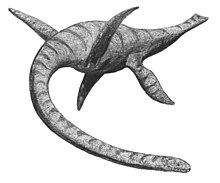Plesiosaurus
| Plesiosaurus Temporal range: Early Jurassic
| |
|---|---|

| |
| Scientific classification | |
| Kingdom: | |
| Phylum: | |
| Class: | |
| Superorder: | |
| Order: | |
| Suborder: | |
| Family: | Plesiosauridae Gray, 1825
|
| Genus: | Plesiosaurus Conybeare, 1821
|
| Species | |
| |
Plesiosaurus (Greek: πλησιος/plesios, near to + σαυρος/sauros, lizard) was a large marine sauropterygian reptile that lived during the early part of the Jurassic Period, and is known by nearly complete skeletons from the Lias of England and Germany. It was distinguished by its small head, long and slender neck, broad turtle like body, a short tail, and two pairs of large, elongated paddles. It lends its name to the order Plesiosauria, of which it is an early, but fairly typical member.
Discovery
Plesiosaurus was one of the first of the "antediluvian reptiles" to be discovered (by Mary Anning), and excited great interest in Victorian England. It was so-named ("near lizard") by William Conybeare, to indicate that it was more like a normal reptile than Ichthyosaurus, which had been found in the same rock strata just a few years previously.
Description

Plesiosaurus was a fairly typical member of its order, and measured around 3 to 5 metres (9.8 to 16.4 ft) in total length. The snout was short, but the mouth was able to open very wide, and the jaws were provided with a series of conical teeth in sockets, much like those of the living gavial. The neck was long and slender, but this seems to have been rather stiff, because the vertebrae are nearly flat-ended, which indicates that it could not have been bent in the swan-fashion represented in many old restorations. The other vertebrae are similarly almost flat-ended and firmly united, and there is no sacrum. The ribs are single-headed, and in the middle of the trunk, between the supports of the paired limbs, they meet a dense plastron of abdominal ribs. The short tail was straight and tapered rapidly.
The pectoral and pelvic girdles which supported the paired limbs are greatly expanded, the pectoral arch being similar to the corresponding bones of turtles.
The limbs were elongated paddles, with five complete digits, although each consists of a very large number of phalanges. Some traces of skin discovered suggest that it was smooth, not scaly.
Ecology

Plesiosaurus fed on belemnites, fish and other prey. Its U-shaped jaw and sharp teeth would have been like a fish trap. It propelled itself by the paddles, the tail being too short to be of much use. Its neck could have been used as a rudder when navigating during a chase.
It is unknown if Plesiosaurus laid eggs on land like sea turtles or give live birth in the water like sea snakes. The young might have lived in estuaries before going in the open ocean.
Species
At one time, Plesiosaurus was a wastebasket taxon used to describe any Mesozoic plesiosaur of generally similar appearance. More recently there has been a number of revisions in sauropterygian taxonomy, and many species previously included here have been moved to other genera and families. Only two species are unambiguiously recognised.
- Plesiosaurus dolichodeirus is the type species, known from the Lower Lias (Sinemurian) of Lyme Regis, which was about three metres long. Other plesiosaurs from the same formation measure between five to six metres in length.
- Plesiosaurus guilelmiimperatoris is known from a large almost complete skeleton from the Upper Lias (Toarcian) of Württemberg. There seems to be the impression of a rhomboidal flap of skin in a vertical plane; if so, many plesiosaurs may have been equipped in this way.
In popular culture
This article contains a list of miscellaneous information. (March 2009) |

- The 1975 film The Land That Time Forgot features a Plesiosaurus attacking the crew of a U-boat.
- A Plesiosaurus is one of the main creatures in Harry Adam Knight's 1984 novel Carnosaur.
- Plesiosaurus is one of the enemies in the Capcom video games Dino Crisis 2 and PS2 sequel Dino Stalker.
- A lake full of Plesiosaurus was encountered during chapter 6 of the PS2, Xbox, PC and GC game Turok Evolution. They were portrayed as very hostile and attack the player even in land by stretching their long neck and biting.
- Plesiosaurus is one of the prehistoric creatures mentioned in Jules Verne's book Journey to the Center of the Earth, in which it fights with an Ichthyosaurus.
References
This article includes a list of references, related reading, or external links, but its sources remain unclear because it lacks inline citations. (April 2009) |
- Richard Owen, Fossil Reptili of the Liassic Formations, pt iii. (Monogr. Palaeont. Soc., 1865)
External links
- Genus Plesiosaurus - The Plesiosaur Directory
- Plesiosauroidea - Palaeos
- Plesiosauria – Mikko's Phylogeny Archive
This article incorporates text from a publication now in the public domain: Chisholm, Hugh, ed. (1911). Encyclopædia Britannica (11th ed.). Cambridge University Press. {{cite encyclopedia}}: Missing or empty |title= (help)







